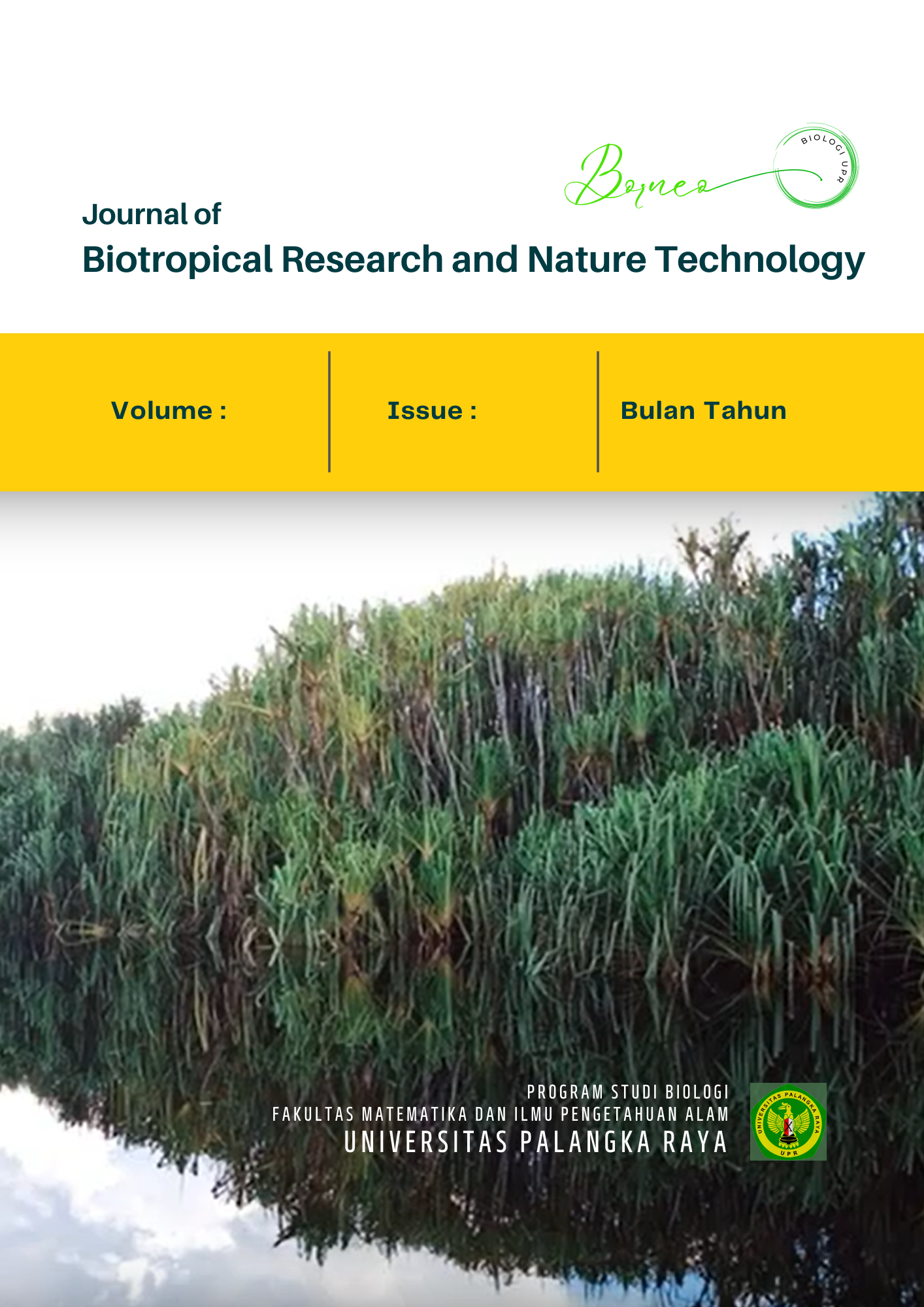Biostimulation of Indigenous Fungi with Agung Banana Semeru Lumajang Peel Extract in Reducing Ammonia Levels
DOI:
https://doi.org/10.52850/borneo.v3i1.15640Abstract
Indonesia is the second rubber producer in the world, in its processing rubber produces liquid waste that contains quite high ammonia levels. This study aims to provide an alternative solution to the problem of water pollution due to ammonia in rubber industry liquid waste using a bioremediation process with a simple bioreactor. This study used indigenous fungi treatment of 4% and banana peel extract of 0%, 5%, and 10%. This study studies the potential of indigenous fungi with banana peel extract nutrients to reduce ammonia levels in water. The parameter measured is the level of ammonia in the water in the bioreactor. The results showed that indigenous fungi with banana peel extract nutrients had an effect on ammonia parameters. Treatment with a concentration of indigenous fungi 4% and banana peel extract 10% had a significant effect on reducing ammonia levels. The more indigenous fungi inoculum and banana extract used, the more effective it is in reducing ammonia in water.
Downloads
References
I. Ekanantari, Outlook Karet Komoditas Pertanian Subsektor Perkebunan. Pusat Data dan Sistem Informasi Pertanian Kementerian Pertanian, 2015.
N. S. Raju, G. V. Venkataram, S. T. Girish, V. B. Raghavendr, and P. Shivashank, “Isolation and Evaluation of Indigenous Soil Fungi for Decolourization of Textile Dyes,” J. Appl. Sci., vol. 7, no. 2, pp. 298–301, Jan. 2007, doi: 10.3923/jas.2007.298.301.
M. I. AlKahfi, Y. A. Razikah, and E. Nurisman, “Pengolahan limbah cair amonia pada industri pupuk secara mikrobiologis dengan bakteri petrofilik,” J. Tek. Kim., vol. 27, no. 3, pp. 74–81, Nov. 2021, doi: 10.36706/jtk.v27i3.686.
T. A. Nainggolan, S. Khotimah, and M. Turnip, “Bakteri Pendegradasi Amonia Limbah Cair Karet Pontianak Kalimantan Barat,” vol. 4, pp. 69–76, 2015.
D. N. R. Sari and S. D. Anitasari, “Isolation of Indigenous Fungi in River Containing Ammonia from Rubber Industry Waste in Jember,” J. Multidiscip. Appl. Nat. Sci., vol. 2, no. 1, pp. 58–64, Jan. 2022, doi: 10.47352/jmans.2774-3047.109.
R. Fitriadi, Haeruddin, and C. A’in, “Efektivitas Mikroorganisme Sebagai Bahan Bioremidiasi Pada Limbah Pencucian Ikan Tongkol (Auxis thazard) (Skala Laboratorium),” vol. 12, no. 1, pp. 52–59, 2016.
A. Rosmana et al., “Systemic Deployment of Trichoderma asperellum in Theobroma cacao Regulates Co-occurring Dominant Fungal Endophytes Colonization,” vol. 12, no. 3, pp. 1071–1084, 2018.
W. Marthalia and D. Oktiani, “Biofiltrasi Menggunakan Kultur Saccharomyces Cerevisiae ATCC 9763 dan Ragi Kering Instan dengan Media Komposit Karbon aktif dan Onggok untuk Mengurangi gas ammonia pada Industri Karet BiofiltrationwithCultureof Saccharomyces cerevisiae ATCC 9763 andInstan,” Pros. Semin. Nas. Kulit Karet Dan Plast., vol. 6, pp. 137–148, 2017.
A. Eskalen et al., “Host Range of Fusarium Dieback and Its Ambrosia Beetle (Coleoptera: Scolytinae) Vector in Southern California,” Plant Dis., vol. 97, no. 7, pp. 938–951, Jul. 2013, doi: 10.1094/PDIS-11-12-1026-RE.
M. Mbenoun, E. H. Momo Zeutsa, G. Samuels, F. Nsouga Amougou, and S. Nyasse, “Dieback due to Lasiodiplodia theobromae , a new constraint to cocoa production in Cameroon,” Plant Pathol., vol. 57, no. 2, pp. 381–381, Apr. 2008, doi: 10.1111/j.1365-3059.2007.01755.x.
A. Prastiawan, D. Jubaedah, and M. Syaifudin, “Pemanfaatan Karbon Aktif Kulit Pisang Kepok (Musa Acuminate L.) Pada Sistem Filtrasi Budidaya Ikan Nila (Oreochormis Niloticus),” Akuakultur Rawa Indones., vol. 7, no. 1, pp. 55–66, 2019.
I. Kandida, M. Tari, and A. Fatiqin, “Effectiveness of the Combination of Green Betel Leaf Extract (Piper betle) and Mint Leaf (Mentha piperita) as Antibacterials against Streptococcus mutans,” Bioactivities, vol. 1, no. 1, pp. 32–38, Jun. 2023, doi: 10.47352/bioactivities.2963-654X.184.
A. Kharisma and A. Manan, “Kelimpahan Bakteri Vibrio Sp. Pada Air Pembesaran Udang Vannamei (Litopenaeus vannamei) Sebagai Deteksi Dini Serangan Penyakit Vibriosis,” vol. 4, no. 2, pp. 129–134, 2012.
D. Nur and D. Susilo Kristian, “Semeru Dan Mas Kirana Phytochemicals Analysis Of Agung Semeru And Mas Kirana Peel Extract,” vol. 2, pp. 64–75, 2017.
M. M. Banin, Y. Yahya, and H. Nursyam, “Pengolahan limbah cair industri pembekuan ikan kaca piring (Sillago sihama) menggunakan kombinasi bakteri Acinetobacter baumannii, Bacillus megaterium, Nitrococcus sp. dan Pseudomonas putida secara aerob,” J. Trop. AgriFood, vol. 3, no. 1, p. 49, Sep. 2021, doi: 10.35941/jtaf.3.1.2021.6119.49-62.
M. Parapouli et al., “Saccharomyces cerevisiae and its industrial applications,” AIMS Microbiol., vol. 6, no. 1, pp. 1–32, 2020, doi: 10.3934/microbiol.2020001.
I. A. Setyowulan, E. P. Nurlaili, F. Nurdyansyah, and U. H. A. Hasbullah, “Pengaruh Konsentrasi Substrat Tepung Kulit Pisang Kepok Dan Kecepatan Pengadukan Terhadap Pertumbuhan Lactobacillus acidophilus,” J. Teknol. Pertan. Andalas, vol. 22, no. 2, p. 118, Sep. 2018, doi: 10.25077/jtpa.22.2.118-125.2018.
Y. B. Kadarusman and A. G. Herabadi, “Improving Sustainable Development within Indonesian Palm Oil: The Importance of the Reward System,” Sustain. Dev., vol. 26, no. 4, pp. 422–434, Jul. 2018, doi: 10.1002/sd.1715.
S. Dewi, “Pengurangan Kadar Oksalat Pada Umbi Talas Dengan Penambahan Arang Aktif Pada Metode Pengukusan,” J. Apl. Teknol. Pangan, vol. 6, no. 2, 2017, doi: 10.17728/jatp.191.
R. H. Lestari, M. Rusdy, Sema, and S. Hasan, “Effect of Liquid Organic Fertilizer and Defoliation Interval on Growth Characteristics and Quality of Elephant Grass CV.Taiwan,” Int. J. Sci. Res. Publ. IJSRP, vol. 8, no. 10, Oct. 2018, doi: 10.29322/IJSRP.8.10.2018.p8208.
D. Abol-Fotouh, O. E. A. AlHagar, and M. A. Hassan, “Optimization, purification, and biochemical characterization of thermoalkaliphilic lipase from a novel Geobacillus stearothermophilus FMR12 for detergent formulations,” Int. J. Biol. Macromol., vol. 181, pp. 125–135, Jun. 2021, doi: 10.1016/j.ijbiomac.2021.03.111.
I. Erper et al., “Genetic Diversity and Pathogenicity of Rhizoctonia spp. Isolates Associated with Red Cabbage in Samsun (Turkey),” J. Fungi, vol. 7, no. 3, p. 234, Mar. 2021, doi: 10.3390/jof7030234.
H. S. Sheoran, “Long-Term Effect Of Organic And Conventional Farming Practices On Microbial Biomass Carbon, Enzyme Activities And Microbial Populations In Different Textured Soils Of Haryana State (India),” Appl. Ecol. Environ. Res., vol. 16, no. 3, pp. 3669–3689, 2018, doi: 10.15666/aeer/1603_36693689.
C. A. S. Ribeiro et al., “One-pot synthesis of sugar-decorated gold nanoparticles with reduced cytotoxicity and enhanced cellular uptake,” Colloids Surf. Physicochem. Eng. Asp., vol. 580, p. 123690, Nov. 2019, doi: 10.1016/j.colsurfa.2019.123690.
E. Chamani, S. K. Tahami, N. Zare, R. Asghari-ZAKARIA, M. Mohebodini, and D. Joyce, “Effect of Different Cellulase and Pectinase Enzyme Treatments on Protoplast Isolation and Viability in Lilium ledebeourii Bioss.,” Not. Bot. Horti Agrobot. Cluj-Napoca, vol. 40, no. 2, p. 123, Nov. 2012, doi: 10.15835/nbha4028055.
C. Conter, E. Oppici, M. Dindo, L. Rossi, M. Magnani, and B. Cellini, “Biochemical properties and oxalate‐degrading activity of oxalate decarboxylase from bacillus subtilis at neutral pH,” IUBMB Life, vol. 71, no. 7, pp. 917–927, Jul. 2019, doi: 10.1002/iub.2027.
Downloads
Published
How to Cite
Issue
Section
License
Copyright (c) 2024 Dwi Nur Rikhma Sari, Septarini Dian Anitasari, Firda Sukma Nadifa

This work is licensed under a Creative Commons Attribution-ShareAlike 4.0 International License.
- Authors retain copyright and acknowledge that the Journal of Multidisciplinary Applied Natural Science is the first publisher, licensed under a Creative Commons Attribution-Share Alike 4.0 (CC BY-SA).
- Authors are able to enter into separate, additional contractual arrangements for the non-exclusive distribution of the journal's published version of the work (e.g., post it to an institutional repository or publish it in a book), with an acknowledgment of its initial publication in this journal.
- Authors are permitted and encouraged to post their work online (e.g., in institutional repositories or on their website) prior to and during the submission process, as it can lead to productive exchanges and earlier and greater citation of published work.








